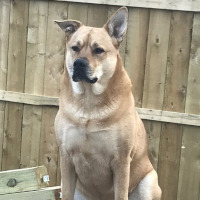 |
Labrakita |
|
He is not recognized by the F.C.I. |
Origin |
Canada <> Japan -> U.S.A. | |
Translation |
Francis Vandersteen |
A brief presentation of the Labrakita |
| Labrakita hybrids are a combination of the Akita Inu and the Labrador Retriever. It's a large breed that's known for being an excellent family dog, but not patient enough to tolerate small children. They make excellent guard dogs because they are protective and don't trust strangers, but they will need to be well trained not to attack guests or other animals. Socialization is important in the Labrakita to get along with other pets. It's a highly intelligent breed that learns quickly and should be easy to train, but can sometimes require a little more patience. |
History of the Labrakita |
| Your Labrakita's history should be determined by examining the histories of its parent breeds. |
A little of the Labrador Retriever |
||
| The Labrador Retriever originated in Canada when it was known as the St. John's Water Dog for the capital of Newfoundland, where it was found in the 1800s. The breed then received its modern name from the Labrador Sea, where it was developed. They are excellent water retrievers and hunters, made popular by the second Earl of Malmesbury. They almost disappeared in the late 1800s due to strict laws and taxes in Newfoundland, and were reinforced in England in 1903. They are the most popular dog breed in the United States and have been registered with the American Kennel Club since 1917. | ||
 |
||
| Standard of the Labrador Retriever | ||
A little of the Akita Inu |
||
| The Akita Inu originated in Japan in the 1600s from the Northern Spitz and was mainly used for hunting big game such as bear, wild boar, deer and elk. Some also used them in dog fighting until the sport was banned. Some say the breed was named after the place where it was first found in Akita prefecture on the island of Honshu. Others believe they came from the snow-capped mountains and were called Snow Country Dogs before becoming known as Akita Inu. In Japan, the Akita has been considered a national treasure since 1937, thanks to the loyalty of an Akita named Haichiko. This loyal dog met his owner at the station after work every day, and after the owner's death, Haichiko continued to go to the station every day to wait for him. There is now a statue in the station in Haichiko's honor. Helen Keller became the first American to own an Akita when she received one as a gift from the Japanese government during her visit to the country. The American Kennel Club finally took notice some 40 years later when they were officially recognized in 1972. The Akita Inu is now the 46th most popular dog breed in America. | ||
 |
||
| Standard of the Akita Inu |
Appearance of the Labrakita |
| The Labrakita can have brown, hazel or amber eyes and a black or brown nose. They have a long muzzle and intelligent expression, often appearing to smile. Their ears are triangular and set high on the head, but can be flexible, depending on the parents. Their dense coat is short to medium-length, straight and may be black, gray, brown, red, cream, fawn, white, piebald or brindle. They may have a pale or white mask and chest. The Labrakita has a large, square head and stocky body with muscular legs, and its long tail can curve slightly over the back or curl completely like the Akita Inu's tail. |
Temperament of the Labrakita |
| Your Labrakita should be a good family companion in a household with children, but they need to be well supervised with young children. They like other pets but need to be socialized young and may need to be supervised with cats due to their prey instinct. The Labrakita is a fun pet that needs lots of play time and does best in a home with a family that has a large yard and plenty of time. They need to be introduced to your guests so they know how to be friendly and should be fairly easy to train with patience. |
Needs and activities of the Labrakita |
| Labrakitas need plenty of exercise to stay healthy and happy. These dogs tend to become overweight and anxious if they don't get enough exercise, so they need at least 60 to 90 minutes of vigorous activity every day. Some of their favorite exercises include playing at the dog park or hiking in the woods, swimming and playing at the beach, taking brisk walks or running around the neighborhood a few times a day, and they're especially happy to be outside hunting local wildlife. If they don't get enough exercise, they can develop bad habits like chewing on objects and destroying property. |
Maintenance of the Labrakita |
| Your Labrakita is a clean dog that grooms itself like a cat, but it still needs to be brushed often. In fact, it's best to brush them with a pincushion or smooth brush several times a week, but only bathe them if absolutely necessary, as frequent shampooing can dry out the skin. Their nails should be trimmed about once a month, or whenever you hear them clacking on the floor. Be sure to brush your dog's teeth several times a week to avoid dental problems. It's also advisable to clean his ears every week and check for earwax build-up, irritation and mites. |






 English (United Kingdom)
English (United Kingdom)